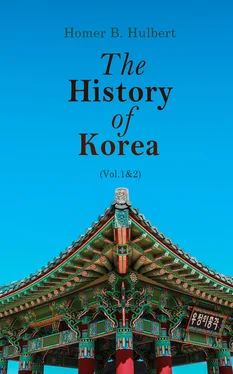Up to this time China had looked on with complacency at the growth of Ko-gu-ryŭ but now Wang-mang the usurper had seized the throne of the Han dynasty. His title was Hsin Whang-ti. One of his first acts seems to have been directed against the powerful little kingdom that had supplanted the two provinces of Tong-bu and P‘yŭng-ju into which China had divided northern Korea. He was probably suspicious of a rapidly growing and thoroughly warlike power which might at any time gather to its standards the wild hordes of the north and sweep down into China.
Here was the beginning of a long struggle which lasted with occasional intermissions until Ko-gu-ryŭ was finally destroyed some eight centuries later. Ko-gu-ryŭ was uniformly China’s foe and Sil-la was as uniformly her friend and ally. Păk-je was now one and now the other. It may be in place to say here that the three powers that divided the peninsula between them were strongly differentiated. Ko-gu-ryŭ in the north was a strong, energetic, fierce, unscrupulous military power, the natural product of her constituent elements. Sil-la was the very opposite; always inclined toward peace and willing oftentimes to make very large concessions in order to secure it. Her policy was always to conciliate, and it was for this mainly that at the last China chose her as the one to assume control of the whole peninsula. Păk-je differed from both the others. She was as warlike as Ko-gu-ryŭ but as weak in military resources as Sil-la. She therefore found her life one scene of turmoil and strife and she was the first of the three to succumb.
It was in 12 A.D. that Wang-mang sent an envoy to Yu-ri, king of Ko-gu-ryŭ, demanding aid in the work of subduing the wild tribes of the north. This was refused by the headstrong Yu-ri, but the Emperor compelled him to send certain troops to accompany the Chinese army. They however took advantage of every opportunity to desert, and large numbers of them formed a marauding band that penetrated the Liao-tung territory and plundered and killed on every hand. For this cause the Emperor sent against Ko-gu-ryŭ a strong force under Gen. Om-u, who speedily brought the recalcitrant Yu-ri to terms, took away his title of royalty and left him only the lesser title of Hu or “Marquis.” From that day began the policy of reprisals on Chinese territory which Ko-gu-ryŭ steadily pursued until it cost her life.
These were stirring days in all three of the kingdoms of the peninsula. In 14 A.D. Ko-gu-ryŭ extended her territory northward by the conquest of the Yang-măk tribe and at the same time she seized a strip of land beyond the Liao River This shows that the castigation inflicted by Wang-mang had not been very severe.
At the same time Sil-la was being harrassed along her southern sea-board by Japanese corsairs, and while her small army was busy driving these out the wild people of Nang-nang attacked her on the north. It is said that one night a meteor fell in their camp and frightened them back to their own country and thus Sil-la was saved.
Two years later the king Yu-ri of Ko-gu-ryŭ died and his son Mu-hyŭl ascended the throne, bestowing on his father the title Tong-myŭng or “Eastern Brightness.” The same year saw a remnant of the overthrown kingdom of Ma-han, under the leadership of Captain Chu-geun, attempt to wrest the scepter from Păk-je and restore the fallen house, but they were defeated and together with their wives and children were put to the sword. About this time an ancient royal seal was unearthed in northern Sil-la, where Kang-neung now lies. It became the royal seal of Sil-la.
The next year Ko-gu-ryŭ, ever on the lookout for aggrandisement, made the conquest of Pu-yŭ, the land from which Chu-mong had fled. The tradition is as follows. Ta-so the king of Pu-yŭ, had become possessed of a red crow with two bodies but only one head. The soothsayers said “Two countries will be joined under one head”. The king replied “Then it means that I shall conquer Ko-gu-ryŭ.” So he sent the bird to the king of Ko-gu-ryŭ as a gage of war, but that astute monarch replied “Red is the color of the south. I shall therefore conquer you.” Thereupon he took the initiative and sent a powerful army northward to make good his threat. The story says that as the army entered Li-mul forest the soldiers found swords clashing together but wielded by invisible hands. These they seized and hastened on. Soon they were joined by a gigantic warrior with a white face who joined their party and gave his name as Kwe-yu.
Approaching the capital of Pu-yŭ, they brought up at night before an extensive marsh. The Pu-yŭ king, thinking to surprise them by a night attack, attempted to cross the marsh, but became mired. The giant Kwe-yu dashed into the swamp and brought to the Ko-gu-ryŭ king his rival’s head. Upon this the Pu-yŭ forces surrendered; all but the brother of the fallen king who fled with a hundred followers and settled near the Ya-lu River, calling the place Kal-sa. This Ko-gu-ryŭ winked at.
In 24 A.D. the king of Sil-la died, having nominated as his successor not his son but Sŭk-t’al-hă his son-in-law. After the obsequies had been performed Sŭk-t’al-hă insisted that the prince assume the throne, but he in turn insisted that the dead king’s orders be followed. As a compromise Sŭk-t’al-hă proposed that they should find a man with sixteen teeth in his upper jaw, as this was a sign of unusual wisdom, and that upon him the throne should be bestowed. When it came to the test, it was found that the prince himself was the man. He could no longer refuse and ascended the throne under the title of Yi-sa-geum, or “Sixteen Teeth.” The present word In-gum which means “king” was doubtless derived from or is a corruption of this Sil-la word.
Meanwhile Ko-gu-ryŭ had been pushing her conquests steadily. Kă-ma and Ku-da, two northern districts or “kingdoms” were absorbed and other conquests were contemplated. The Emperor beheld these enlargements of Ko-gu-ryŭ with some concern and in 27 A.D. sent a strong force to bring her to terms. At the first encounter the forces of Ko-gu-ryŭ were routed and fell back toward the capital which, as we have seen, was then at or near the present town of Eui-ju. The king hastily summoned a council of war at which it was decided to man the walls of the capital and try to hold out until the enemy should be compelled by lack of food or the severity of the weather to raise the siege. The Chinese knew that there was little water within the wall and had high hopes of compelling a speedy surrendersurrender. This was all too true and there was soon much distress in the city; but a certain courtier said “If you will give me all the fish in the city I will undertake to make the enemy raise the siege or I will pay the penalty with my life.” He was given permission and soon he had the soldiers along the wall going through the motions of a bath, using fish scales for water. The scales glittered in the sun like drops of water and the enemy supposing that there must therefore be a good store of water in the city despaired of taking it by siege and so struck their tents and returned to China.
The marked difference between Ko-gu-ryŭ and Sil-la was well illustrated by the events of this year. While Ko-gu-ryŭ was reaching out covetous hands in every direction and carrying fire and sword into the hamlets of inoffensive neighbors, Sil-la was pursuing a course of such good will to all both without and within her borders that natives of the wild tribes to the north of her came in large numbers and settled on her soil, glad to become citizens of so kind and generous a land. The king himself made frequent tours of the country alleviating the distress of widows, orphans and cripples. It was in 32 B.C. that he changed the name of the six original families which united in founding Sil-la. The men of Yang-san, Ko-hŭ, Tă-su, Ul-jin, Ka-ri, and of Myŭng-whal were named respectively Yi, Ch’oé, Son, Chöng, Pă and Sŭl. These names will be recognised at once as among the most common patronymics in Korea at the present day, which adds confirmatory evidence that Korea of to-day is essentially the Korea of the south. When we add to this the fact that the names Pak, Kim, An, Ko, Sŭk, Yang, So, Sŭ, Kwŭn, Pă, Im, Na, Hyŭn, Kwak, Ho, Whang, Chang, Sim and Yu originated in southern Korea the argument becomes well-nigh conclusive. The only names of importance that did not originate in southern Korea are Min, Song, Om, Cho, and Han; and many of these originated in what must have been Ma-han territory. At the same time the king established seventeen official grades and called them respectively I-bŭl-son, I-ch’ŭk-son, I-son, P’a-jin-son, Tă-a-son, A-son, Kil-son, Sa-son, etc.
Читать дальше












